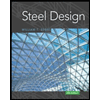
(a)
The satisfaction of AISC interaction equation using LRFD.
Answer to Problem 6.2.1P
The member satisfies the AISC interaction equation.
Explanation of Solution
Given:
The load is
The length of member is
The value of
The flexural load is
Concept Used:
Write the LRFD interaction equation.
Here, the factored load is
Calculation:
Calculate the factored load.
Here, the dead load is
Substitute
Calculate the effective length of the member.
Here, the unsupported length is
Substitute
Calculate the axial compressive design strength.
From the manual table, the axial compressive design strength of a
Calculate the nominal flexural strength about x-axis.
From the design table, calculate the nominal flexural strength about x-axis by using
Calculate the flexural load about x-axis.
Here, the flexural dead load is
Substitute
There is no bending about y-axis, therefore
Write the equation to calculate the controlling interaction formula.
Substitute
The value is greater than
Calculate the LRFD interaction equation.
Substitute
The interaction equation is satisfied.
Conclusion:
Therefore, the interaction equation is satisfied with the AISD interaction equation.
(b)
The satisfaction of AISC interaction equation using ASD.
Answer to Problem 6.2.1P
The member satisfies the AISC interaction equation.
Explanation of Solution
Concept Used:
Write the ASD interaction equation.
Here, the factored load is
Calculation:
Calculate the factored load.
Here, the dead load is
Substitute
Calculate the allowed compressive strength.
From the manual table, the allowed compressive strength of a
Calculate the nominal flexural strength about x-axis.
From the design table, calculate the nominal flexural strength about x-axis by using
Calculate the flexural load about x-axis.
Here, the flexural dead load is
Substitute
There is no bending about y-axis, therefore
Write the equation to calculate the controlling interaction formula.
Substitute
The value is greater than
Calculate the ASD interaction equation.
Substitute
The interaction equation is satisfied.
Conclusion:
Therefore, the interaction equation is satisfied with the ASD interaction equation.
Want to see more full solutions like this?
Chapter 6 Solutions
STEEL DESIGN W/ ACCESS
- 6000 units have been installed to date with 9,000 units to install. Labor costs are $23,300.00 to date. What is the unit cost for labor to date?arrow_forwardThe base rate for labor is $15/hr. The labor burden is 35% and 3% for small tools for the labor. There are 1000 units to install. Records indicate that trade workers can install 10 units per hour, per trade worker. The owners need 15% overhead and profit to pay bills, pay interest on loan and provide some profit to the partners. What is the minimum bid assuming no risk avoidance factor?arrow_forwardCan you show me how to obtain these answers thanks, will rate!arrow_forward
- I have the answers for part a just need help with b mostly thanksarrow_forwardPlease explain step by step and show formulasarrow_forward5. (20 Points) Consider a channel width change in the same 7-foot wide rectangular in Problem 4. The horizontal channel narrows as depicted below. The flow rate is 90 cfs, and the energy loss (headloss) through the transition is 0.05 feet. The water depth at the entrance to the transition is initially 4'. 1 b₁ TOTAL ENERGY LINE V² 129 У1 I b₂ TOP VIEW 2 PROFILE VIEW h₁ = 0.05 EGL Y₂ = ? a) b) c) 2 Determine the width, b₂ that will cause a choke at location 2. Determine the water depth at the downstream end of the channel transition (y₂) section if b₂ = 5 feet. Calculate the change in water level after the transition. Plot the specific energy diagram showing all key points. Provide printout in homework. d) What will occur if b₂ = = 1.5 ft.?arrow_forward
- 4. (20 Points) A transition section has been proposed to raise the bed level a height Dz in a 7-foot wide rectangular channel. The design flow rate in the channel is 90 cfs, and the energy loss (headloss) through the transition is 0.05 feet. The water depth at the entrance to the transition section is initially 4 feet. b₁ = b = b2 1 TOTAL ENERGY LINE V² 129 Ут TOP VIEW 2 hloss = 0.05 " EGL Y₂ = ? PROFILE VIEW a) Determine the minimum bed level rise, Dz, which will choke the flow. b) If the step height, Dz = 1 ft, determine the water depth (y2) at the downstream end of the channel transition section. Calculate the amount the water level drops or rises over the step. c) Plot the specific energy diagram showing all key points. Provide printout in Bework. d) What will occur if Dz = 3.0 ft.?. Crest Front Viewarrow_forward1. (20 Points) Determine the critical depth in the trapezoidal drainage ditch shown below. The slope of the ditch is 0.0016, the side slopes are 1V:2.5H, the bottom width is b = 14', and the design discharge is 500 cfs. At this discharge the depth is y = 4.25'. Also, determine the flow regime and calculate the Froude number. Ye= ? Z barrow_forward3. (20 Points) A broad crested weir, 10 feet high, will be constructed in a rectangular channel B feet wide. The weir crest extends a length of B = 120 feet between the banks with 2 - 4 foot wide, round nosed piers in the channel. The width of the weir crest is 8 feet. If H = 6', determine the design discharge for the weir.arrow_forward
 Steel Design (Activate Learning with these NEW ti...Civil EngineeringISBN:9781337094740Author:Segui, William T.Publisher:Cengage Learning
Steel Design (Activate Learning with these NEW ti...Civil EngineeringISBN:9781337094740Author:Segui, William T.Publisher:Cengage Learning
